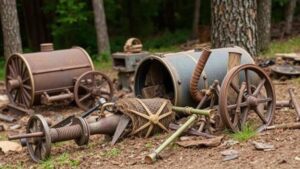Unearthing Ceremonial Items in Rocky Outcrops Near Water Sources
Unearthing Ceremonial Items in Rocky Outcrops Near Water Sources
The intersection of natural geography and human activity has long captivated scholars in anthropology, archaeology, and environmental science. Unearthing ceremonial items in rocky outcrops near water sources presents a unique dimension to our understanding of ancient cultures. This article delves into the significance, methodologies, and implications of these findings.
Geographical and Cultural Context
Rocky outcrops frequently serve as landmarks in various landscapes, often indicating areas with abundant natural resources. In many cultures, proximity to water sources–rivers, lakes, or springs–plays a crucial role in settlement patterns, agriculture, and spirituality.
Regions like the American Southwest, the Mediterranean basin, and parts of South America have yielded ceremonial artifacts amidst rocky terrain. For example, the Ancestral Puebloans of the Southwestern United States utilized natural rock formations in ceremonial practices, often placing altars near water to signify life and renewal. This context raises questions about how geography influenced their spiritual beliefs and practices.
Types of Ceremonial Items Found
Various artifacts recovered from these sites often include:
- Petroglyphs: Rock engravings that may depict rituals, deities, or significant life events.
- Ritual Uses: Items like offerings or tools specifically used during ceremonies.
- Burial Goods: Objects placed with the deceased that reflect the cultural attitudes towards death and the afterlife.
One prominent example includes the rich assemblage of ceremonial stone tools found at the Cliff Palace in Mesa Verde National Park, Colorado, which suggest rites tied to water and agriculture, illustrating the sacred relationship between these cultures and their environments.
Methodologies for Discovery
The discovery and excavation of ceremonial items in rocky outcrops involve several interdisciplinary approaches:
- Field Survey: Systematic pedestrian surveys in targeted areas can help archaeologists identify potential sites of interest.
- Remote Sensing: Techniques such as LiDAR and ground-penetrating radar can unveil hidden features beneath vegetation or soil.
- Excavation Techniques: Stratigraphic excavation allows researchers to understand the sequence of human activity and the context of the artifacts found.
Case studies, such as those conducted by the Archaeological Conservancy, showcase how careful surveying techniques lead to the unearthing of significant ceremonial sites. e methodologies not only help locate artifacts but also contribute to the broader understanding of human history in these regions.
Implications of Findings
The items discovered from such sites represent more than mere artifacts; they provide insight into the spiritual lives of ancient cultures and their interaction with the environment. For example, findings at the La Cueva de los Tayos in Ecuador have revealed not just tools, but also intricate ceremonial structures that suggest complex interactions with nature were integral to these communities..
Also, these findings contribute to a growing body of knowledge regarding cultural heritage preservation. By documenting and analyzing these ceremonial artifacts, archaeologists contribute to efforts aimed at protecting such sites from modern development, looting, and erosion.
Future Directions and Considerations
As technology continues to advance, so too does the potential for discovering more about ancient ceremonial practices. Integration of artificial intelligence in pattern recognition from excavation records may lead to breakthroughs in understanding the significance of spatial relationships between ceremonial items, water sources, and rocky outcrops.
Also, interdisciplinary collaboration involving anthropologists, ecologists, and geologists can enhance our understanding of these relationships, revealing how ancient peoples thrived in harmony with their environments.
Actionable Takeaways
For researchers and enthusiasts alike, several actionable strategies emerge from these discussions:
- Engage with local indigenous communities to gain insight into their historical practices related to ceremonial sites.
- Use modern technologies such as GIS mapping and remote sensing for initial site assessments.
- Promote public awareness campaigns about the importance of preserving these archaeological sites.
To wrap up, unearthing ceremonial items in rocky outcrops near water sources opens a gateway to understanding the multifaceted relationship between ancient peoples and their environments. Through careful study and preservation efforts, we can continue to learn from the rich tapestry of human history that these artifacts represent.


